
* Working from the Terrier and Tartar, in the 1960s the Navy evolved the weapons into the "Standard Missile (SM)" family, which has been continuously refined and remains a first-line weapon -- even capable of surface attack and missile defense.
* Having found the Tartar and Terrier excellent weapons, in the early 1960s the Navy decided to evolve them as the "Standard missile (SM)" family, with the Tartar becoming the "RIM-66 SM MR" -- "MR" for "medium range" -- and Terrier becoming the "RIM-67 SM ER" -- "ER" for "extended range".
Test flights of "YRIM-66A" prototypes began in 1965, with the initial "RIM-66A SM-1MR" variant introduced to service in 1967 for existing Tartar warships. It was built in Blocks I to IV; Blocks I & II may have been prototype only, with Block IV being the main production variant. It was called "Digital Tartar", being effectively a Tartar with a comprehensive avionics update, featuring better resistance to countermeasures, and shorter minimum range. It had the same Mark 27 dual-thrust motor, same continuous-rod warhead, and same performance specs.
The RIM-66A did visibly differ from the Tartar by having distinctive forward extensions on the wings, with these extensions being a good recognition feature of the SM family. However, there are confusions in that; although Tartars didn't have forward extensions on the wings, later-model Terriers did, though they looked more like wedges than airfoils. It is not clear if the wedges served as reinforcements, or had some aerodynamic purpose, or both.
To confuse matters further, images sometimes appear to have been mismarked -- in particular, identifying as a Tartar a missile with forward wing extensions, and presumably a Standard. In sum, while there was a clear evolution in form in the Terrier / Tartar / SM family, trying to nail down precise variants from photos is an exercise in futility.

Anyway, with a Mark 30 single-thrust motor and a Mark 12 booster attached, the RIM-66A became the "RIM-67A SM-1ER", for existing Terrier warships. It is not clear how block updates to the RIM-66 for traditional Tartar warships applied to the RIM-67A. Production of the SM-1 was originally by General Dynamics, with the line later sold off to Hughes, and finally ending up in the hands of Raytheon. It's complicated.
The "RIM-66B" AKA "SM-1MR Block V" was a much more comprehensive update, with an improved seeker, more agile autopilot, plus a new blast-fragmentation warhead, and a more powerful Mark 56 dual-thrust rocket motor, which extended range and ceiling. It was 25 centimeters (10 inches) longer than the RIM-66A, with length extended from 4.47 meters (14 feet 8 inches) to 4.72 meters (15 feet 6 inches), and weight increased by 42 kilograms (93 pounds). In effect, it was new wine in an old bottle, a new weapon in an old airframe. All RIM-66As were updated to RIM-66B standard.
___________________________________________________________________
RIM-66B SM-1MR STANDARD NSAM:
___________________________________________________________________
length:
4.72 meters (15 feet 6 inches)
diameter:
34 centimeters (13.4 inches)
finspan:
1.07 meters (42.3 inches)
weight:
620 kilograms (1,370 pounds)
warhead weight:
60 kilograms (130 pounds)
speed:
Mach 3.5
ceiling:
24,400 meters (80,000 feet)
range:
46 kilometers (29 miles / 25 NMI)
___________________________________________________________________
RIM-67A SM-1ER STANDARD NSAM:
___________________________________________________________________
booster length:
3.81 meters (12 feet 6 inches)
booster finspan:
1.57 meters (62 inches)
booster diameter:
45 centimeters (18 inches)
booster weight:
720 kilograms (1,590 pounds)
overall length:
7.98 meters (26 feet 2 inches)
overall weight:
1,340 kilograms (2,960 pounds)
speed:
Mach 3.5
ceiling:
24,000 meters (80,000 feet)
range:
65 kilometers (40 miles / 35 NMI)
___________________________________________________________________
The "RIM-66C" AKA "SM-2MR Block I", introduced in 1978, was the next step beyond that, integrating the Standard missile into the Aegis combat system, which would be fielded on US Navy TICONDEROGA-class guided missile cruisers and ARLEIGH BURKE-class guided-missile destroyers. The Aegis system was built around the AN/SPY-1 radar, which uses four fixed passive phased-array antennas. Aegis was integrated with all shipboard weapon systems; it could track 100 targets at a time, though the number that could be engaged at one time was much smaller.
The RIM-66C featured a new Mark 115 blast-fragmentation warhead and an inertial / command guidance system. It picked up where the Typhon program had left off, 15 years earlier, providing a missile that didn't need a dedicated guidance system. The Aegis system could program a flight path for the missile before launch, and update it on the fly. The new flight control scheme was much "smarter" and more efficient, increasing effective range to 74 kilometers (46 miles / 40 NMI).
The RIM-66C also had a "monopulse" radar seeker, with a quadrant radar receiver -- which allowed it to determine target speed and direction with a single radar pulse, instead of multiple pulses, increasing its resistance to deception jamming. There were never any RIM-67 / SM-2ER variants for Aegis warships; the first five Aegis cruisers only had the Mark 26 twin-rail launcher, used for Tartar.
The "RIM-66D" was the same as the RIM-66C, but for Tartar ships. The RIM-66D was also known as the "SM-2MR Block I NTU" -- where "NTU" stood for "New Threat Upgrade", a Reagan-era effort in which old Tartar warships were comprehensively upgraded with new combat systems, including the SM-2-series missiles. The "RIM-67B / SM-2ER NTU" was the equivalent for Terrier NTU warships. Incidentally, sources hint that, along with the ability to use the SM-2 missile, NTU warships could share targeting systems, for example with an NTU cruiser firing the missile, while an AEGIS warship guided it to target.
Again, it is not clear how RIM-66 block updates for Tartar NTU warships applied to the RIM-67B -- though there was a "RIM-67C / SM-2ER NTU Block II", with a new Mark 70 booster stage that almost doubled range, to 185 kilometers (160 miles / 100 NMI), and increased speed to Mach 3.5.
The "RIM-66E" AKA "SM-1MR Block VI" was an improved RIM-66B for Tartar warships, introduced in 1983. It leveraged off technology developed for the SM-2, including the monopulse seeker and Mark 115 warhead. It introduced a Mark 45 Mod 4 proximity fuze AKA "Target Detection Device (TDD)"; this was updated to the Mod 6 in the "Block VIA" and Mod 7 in the "Block VIB". The RIM-66E was the last SM variant for older warships not fitted with the NTU system. There was a "RIM-67D / SM-2ER Block III" with the TDD, and a new Mark 30 Mod 4 sustainer motor for the missile stage.
The "RIM-66G" AKA "SM-2MR Block II", introduced in 1983, was for Aegis warships. It featured a new Thiokol Mark 104 solid-fuel rocket motor that almost doubled range, and an improved fragmentation warhead. It was followed by the "RIM-66H" AKA "SM-2MR Block II", which was much the same, but was intended for the "Mark 41 Vertical Launch System (VLS)".

One of the little puzzles of the SM-2 series is that, at some time during the weapon's evolution, the wings / strakes ended up being mid-mounted, instead of extending to the rear. Sources are uninformative on this matter; the wing configuration may have been changed to support VLS, since it is hard to find any images of SM-2 launches from a VLS with the older wing configuration. However, it is possible to find images of SM-2s with the new wing configuration being fired from rail launchers.
The "RIM-66J" AKA "SM-2MR Block II (NTU)" was for Tartar warships, and featured better counter-countermeasures. It was followed by the "RIM-66K-1" AKA "SM-2MR Block III (NTU)" in 1988, which had improved capability against low-altitude targets -- and then the "RIM-66K-2" AKA "SM-2MR Block IIIA (NTU)", introduced in 1991, which had a Mark 125 warhead with a directional blast capability. This was the last of the Tartar-type RIM-66 missiles, with Block II missiles generally updated to Block III standard.
The RIM-66K series was paralleled by "RIM-66L" missile variants for Aegis warships with the Mark 26 rail launcher, including the "RIM-66L-1", with improved capability against low-altitude targets; and the "RIM-66L-2", with the Mark 125 warhead. For Aegis warships with the Mark 41 VLS launcher, there were the "RIM-66M-1" and "RIM-66M-2" variants respectively. The RIM-66L and RIM-66M variants had the same block designations as the RIM-66K variants.
Eventually, Aegis warships would get rid of the Mark 26 launcher, and standardize on VLS. The US Navy has phased out Talos / Terrier NTU vessels, though it appears a few Talos NTU warships linger in foreign navies. Some sources mention that old RIM-67 missiles have been converted into targets, but it's hard to find confirmation of that.
The "RIM-66M-5", introduced in 1998, was the product of the "Missile Homing Improvement Program (MHIP)", adding an infrared homing seeker along with the SARH seeker -- allowing it to defeat anti-radar countermeasures, and also smaller targets. It was the only RIM-66M subvariant that didn't have IMRIM-66K or RIM-66L equivalent. All Block III / IIIA missiles were upgraded to Block IIIB standard.
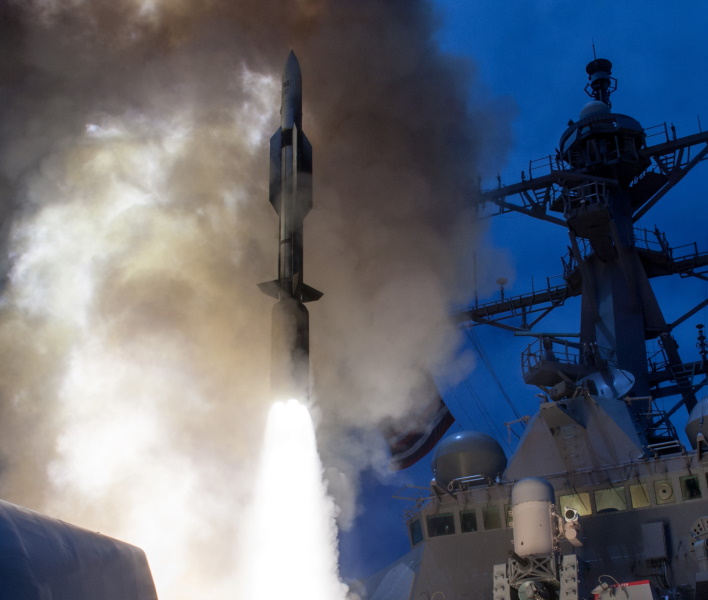
The lack of an ER version of the SM-2 for Aegis vessels led to the development of the "SM-2ER Block IV", AKA "RIM-156A", which was a Block IIIB missile with a Mark 72 solid-fuel booster stage. The Mark 72 was short, allowing the RIM-156 to fit into a VLS silo; it lacked fins, using vectored thrust for steering.
___________________________________________________________________
RIM-66M-5 BLOCK IIIB / SM-1MR STANDARD NSAM:
___________________________________________________________________
finspan:
1.07 meters (42.3 inches )
length:
4.72 meters (15 feet 6 inches)
diameter:
34 centimeters (13.4 inches)
weight:
705 kilograms (1,555 pounds)
warhead weight:
60 kilograms (130 pounds)
speed:
Mach 3.5
ceiling:
> 24,400 meters (> 80,000 feet)
range:
> 160 kilometers (> 100 miles / 85 NMI)
___________________________________________________________________
RIM-156A SM-2ER BLOCK IV STANDARD NSAM:
___________________________________________________________________
booster diameter:
53 centimeters (21 inches)
booster length:
1.86 meters (6 feet 1 inch)
booster weight:
745 kilograms (1,645 pounds)
overall length:
6.58 meters (21 feet 6 inches)
overall weight:
1,450 kilograms (3,200 pounds)
speed:
Mach 3.5
ceiling:
> 33,000 meters (> 110,000 feet)
range:
> 360 kilometers (> 225 miles / 195 NMI)
___________________________________________________________________
* Incidentally, the only known aerial kill of an aircraft by a Standard Missile was on 3 July 1988, in the course of US Navy escorts of tankers in the Persian Gulf during the Iran-Iraq war. The crew of the USS VINCENNES, an early TICONDEROGA-class cruiser with the Mark 26 launcher, spotted an aircraft approaching that they couldn't identify. The captain, Will Rogers, had little time to react, and ordered that the aircraft be fired upon. Two SM-2 missiles were fired, destroying the target.
It turned out to be an Airbus A300 airliner, Flight 665 of Iran Air; all 290 on board were killed. A Navy after-action report chalked up the tragedy to the confusions of war -- though another Navy officer who had been under Rogers' command suggested he was overly aggressive, too quick to open fire. Whatever the case, Rogers became an unfortunate footnote of history. His Navy career may have suffered as well: he never made admiral, and retired in 1991.
Earlier in 1988, on 18 April, the SM-2 played a role in Operation PRAYING MANTIS, a retaliatory attack for the mining of the US Navy frigate SAMUEL B. ROBERTS four days earlier. The Americans attacked two oil platforms being used as operational bases by the Iranians, while sinking an Iranian frigate, gunboat, and three fast attack boats. SM-2s were used in the course of the action.
It wasn't until 2016 that the SM-2 was used again. In October of that year, during the Saudi-driven war in Yemen, the US Navy destroyer USS MASON was repeatedly fired upon by Houthi rebels, who launched antiship missiles at the vessel. The missiles were defeated by countermeasures, SM-2s, and Evolved Sea Sparrow SAMs. On 13 October the USS NITZE, another US Navy destroyer, launched three Tomahawk cruise missiles to neutralize Houthi radar stations that were directing the attacks. It is an indication of the changes in maritime warfare since the end of World War II that shootouts at sea have largely become a thing of the past.
* The SM family featured a number of offshoots. During the Vietnam War, US attack aircraft used the "AGM-45 Shrike" anti-radar missile (ARM), which was an AIM-7 Sparrow air-to-air missile (AAM) with a radar-homing seeker. It lacked range and hitting power, so the early-model RIM-66 was modified for air carriage and fitted with a radar homing seeker, to become the "AGM-78A Standard ARM (STARM)". It was used by both the US Navy and US Air Force -- indeed, it seems the USAF was the primary user.
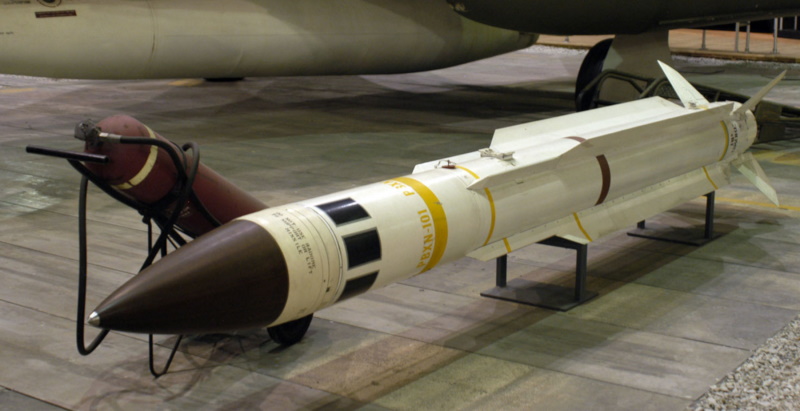
Refined "AGM-78B" and "AGM-78C" versions were built, with total production being over 3,000 missiles before end of production in 1976. The AGM-78 STARM remained in service into the late 1980s, when it was replaced by the "AGM-88 High-Speed ARM (HARM)", which was more or less a scaled-up Shrike. An "RGM-66D" shipboard ARM was also developed, though it is unclear how much service it saw.
There was work to develop a long-range AAM, the "AIM-97 Seekbat", based on the Standard missile, but it never entered service. The eccentric name was based on the fact that the AIM-97, in part, intended to deal with the high-performance Soviet MiG-35 "Foxbat" interceptor / reconnaissance aircraft. The need was met by the AIM-54 Phoenix missile. During the 1990s, the US Marines also tried to develop a precision-strike surface-to-surface missile, the "RGM-165", based on the Standard,
Iran obtained the SM-1 NSAM in the 1970s, before the fall of the Shah, and eventually built it themselves, as the "Sayyad-2". It uses a guidance system derived from that of the "Sayyad-1" SAM, an Iranian-made version of the Chinese HQ-2 SAM, which is in turn an improved derivative of the classic Russian S-75 Dvina / NATO SA-2 "Guideline" SAM. It is not clear how the guidance system works; the original S-75 SAM used a target-tracking and a missile-tracking radar, with control updates sent to the missile, much like the MASURCA guidance system. However, the Chinese appear to have enhanced the S-75 to a degree.
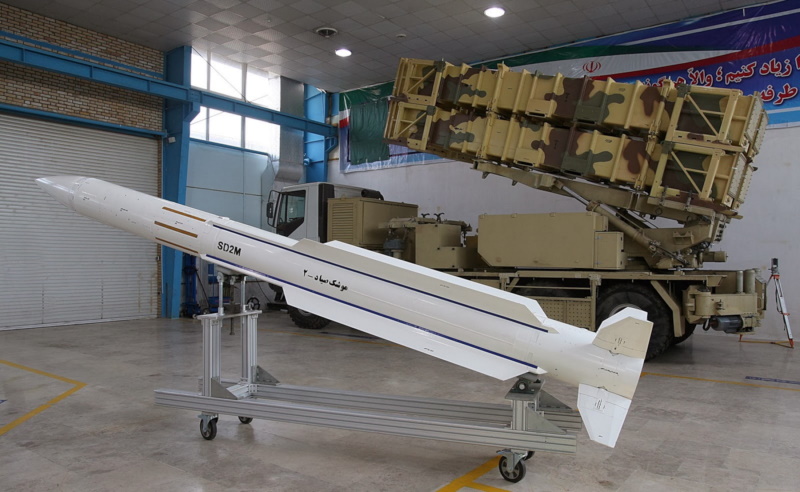
The Sayyad-2 is the attack element of the "Talaash" mobile air-defense system. The missile is canister-launched, from a wheeled vehicle with four canisters in a 2 x 2 arrangement; presumably, the air-defense system can be mounted on naval vessels as well. There are mentions of further improved "Sayyad-3" and "Sayyad-4" SAMs, but it appears they don't look so much like the Sayyad-2.
BACK_TO_TOP* Under the "Navy Area Wide (NAW)" program, the US conducted work on a "RIM-156B / SM-3ER Block IVA" that would have ABM capability, but the program went out of control, and was canceled in late 2001. In 2003, the Navy awarded a contract to Raytheon to develop a follow-on to the RIM-156A under the "Extended Range Active Missile (ERAM)" program, this weapon not intended to have ABM capability.
The resulting "RIM-174 / SM-6 Standard ERAM Block I" was fielded from 2013, complementing Block IIIB SM-2s in service. It looked just like the RIM-156A, but featured an active radar seeker derived from that used on the AIM-120 AMRAAM air-to-air missile -- also built by Raytheon. It was not fitted with an infrared seeker. The SM-6's ability to self-target gave it an over-the-horizon capability, with a range of up to 370 kilometers (230 miles / 200 NMI). It also supported the "Cooperative Engagement Capability", able to be guided by radars from vessels other than the one that launched the missile -- and ultimately, to be guided by air platforms like the Lockheed F-35 strike fighter.
It was followed by the "Block IA", which added GPS guidance for attacking ground targets -- which was followed in turn by the "Block IAU", with a completely new guidance system. The active radar seeker has been retrofitted to the SM-2 Block IIIB, resulting in the "Block IIIC". The SM-2 "Block IIICU" went to the same redesigned guidance system as the SM-6 Block IAU.
Surprisingly, the SM-6 has been adopted by the US Army, but not for air defense. The Army has been working on a "Long-Range Precision Fires (LRPF)" effort, involving long-range precision strike on surface targets, with LRPF including a "Mid-Range Capability (MRC)" system, along with shorter- and longer-range systems.
The MRC system, named "Typhon" -- of course, no particular relation to the old RIM-50 Typhon -- can hit surface targets somewhere in the 500 to 1,800 kilometer (310 to 1,120 mile) range, with both the SM-6 and the Tomahawk cruise missile being launched by the system. The MRC system includes transporter / erectors / launchers (TEL), missiles, a battery operations center, and support vehicles. The TELs carry a quadruple launcher based on the Mark 41 VLS, raising it to the vertical position for launch.
Lockheed Martin has built the launcher in the format of a standard shipping container as the "Payload Deployment System (PDS)" AKA "Mark 70 MOD1 Expeditionary Launcher", with test launches from 2019. Initial fielding of the MRC was in 2023. The US Army, as discussed earlier, is rethinking its air defense strategy, and has been thinking about also fielding the SM-6 as a SAM system.
Although not much has been said about it, images have surfaced of the SM-6 as a very-long-range AAM, said to be designated "AIM-174B", being carried for test and evaluation by US Navy Super Hornets. It could be intended in part for service in Ukraine, where a long-range air intercept capability is badly needed.
* In the meantime, alongside the NAW program, as mentioned earlier the Navy was conducting a "Navy Theater Wide (NTW)" program, towards a specifically-designed ABM weapon. The result was the "SM-3", with testing of the developmental "RIM-161A / SM-3 Block I" begun in 2001. The SM-3 also looked much like the SM-156A, but it had a fast-burn / high-acceleration booster stage, and was actually a three-stage weapon -- with an HTK upper stage, the "Lightweight Endo-Atmospheric Projectile (LEAP)". The HTK vehicle was intended for "endo-atmospheric intercept", meaning it could hit targets in near-space. The SM-3 used a Global Positioning System satellite receiver and inertial navigation system for midcourse guidance.
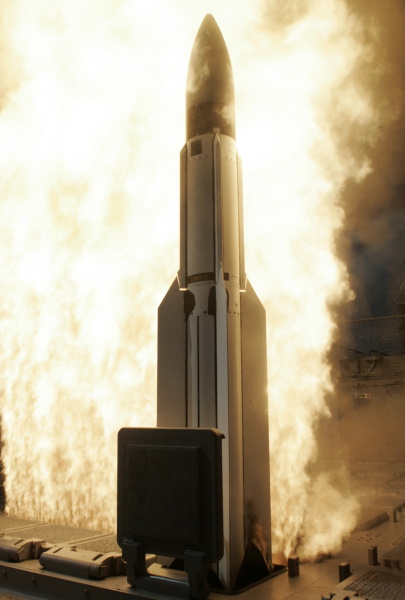
Aegis warships enhanced to launch the SM-3 had to be brought up to AN/SPY-1E radar configuration -- which was an AESA radar, as opposed to the passive arrays of earlier variants. Only a few Aegis warships were updated to the AN/SPY-1E at the outset. The SM-3 was fielded in 2006, the initial operational version being the "RIM-161B / SM-3 Block IA", with a one-color infrared seeker and capable of engaging MRBMs. The Block IA was followed by the "RIM-161C / SM-3 Block IB", updating the Block IA with a kill vehicle featuring an improved two-color seeker, avionics, and maneuvering thruster system; it was capable of engaging IRBMs.
Ongoing testing of the RIM-161 demonstrated growing improvement in intercepting ballistic missiles, though progress was by no means in a neat straight line. In one particularly interesting exercise, on 20 February 2008 an SM-3 fired from the Aegis cruiser LAKE ERIE from off of the Hawaiian Islands actually intercepted a satellite. The satellite was a classified spacecraft, designated "NROL-21", that had failed in orbit after being launched in December 2006.
It was falling to Earth anyway, with the stated rationale for the interception merely to ensure that it was broken up thoroughly so it wouldn't present a hazard when it came down. However, the Chinese had performed a test of an antisatellite system not long before, and it seems plausible the Americans wanted to drop a hint that they had the capability to respond in kind. If so, the hint appears to have been effective, since the Chinese protested loudly.
The Block IB was followed in turn by the developmental "RIM-161D / SM-3 Block II", intended to provide much greater range, with the diameter of the missile stage increased from 34 to 53 centimeters (13.4 inches to 21 inches) -- matching the width of the fast-burn booster. It is not clear if the SM-3 Block II was ever flown; it was refined into the production "Block IIA", with a bigger kill vehicle, featuring a smarter seeker and more powerful divert thrusters. It was capable of engaging ICBMs.
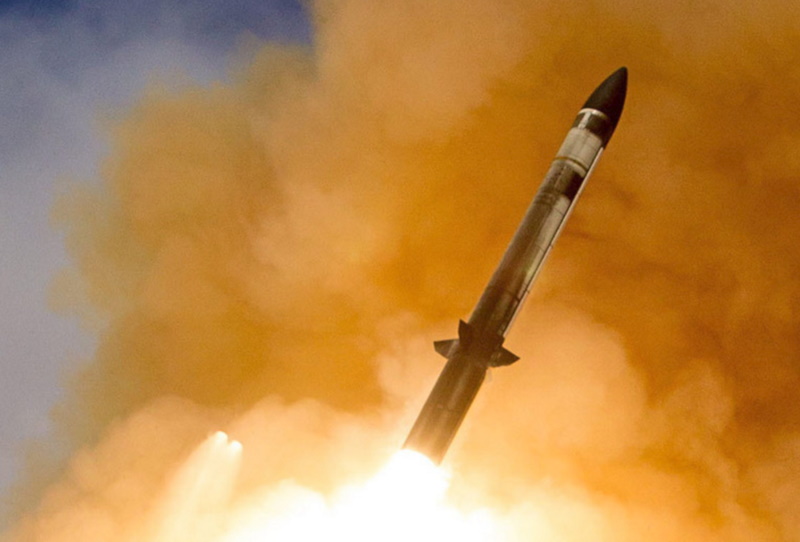
Japan collaborated in this stage of the effort. Raytheon was awarded a contract in 2019 for an initial production batch of Block IIA missiles, with Japan to get its share. There was to be a "Block IIB", but it was canceled in 2013. The Block IIA represented a dramatic evolution of the Standard Missile family, tracing its roots back to the RIM-2 Terrier, conceived in the 1940s, as an outgrowth of the STV test vehicles. The RIM-174 is now also being updated with a 53-centimeter / 21-inch missile stage as the "SM-6 Block IB", to be introduced to service after 2024. Navy documents suggest it may have a hypersonic surface-attack capability; it may be fielded with the Army Typhon MRC system.
A land-based variant of the NTW system, named "Aegis Ashore", has been developed, with a ground-based AN/SPY-1 system -- by all appearances, the shipboard system mounted on concrete -- and an SM-3 VLS battery. One site was set up in Romania, going into operation in 2016, with a second site in Poland going into operation in 2024. Incidentally, the Patriot PAC-3 SAM has been adapted to VLS launch and integrated into Aegis, with test launches from Aegis Ashore having been performed. At present, however, there's no plan to field the Patriot with Aegis.
* A summary list of SM variants follows:
* Sources include:
* Illustrations credits:
* This document started life as one on US Navy SAMs, originally released in July 2020, and one on US Army SAMs, in September 2022. The merged version was released in October 2020 as "v2.0.0".
* Revision history:
v2.0.0 / 01 oct 22 / Consolidated SAMs document. v2.1.0 / 01 aug 24 / Review, polish, & update. v2.2.0 / 01 sep 24 / Added short-range air defenses.BACK_TO_TOP
